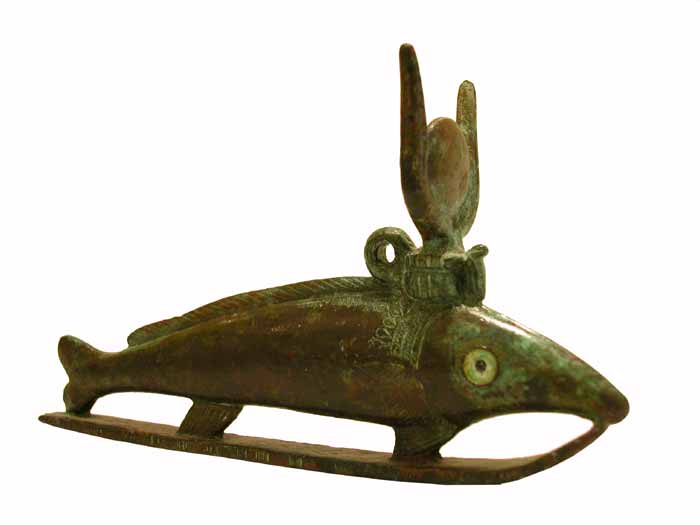Bronze Sculpture of an Oxyrhynchus Fish God, 664 BCE - 525 CE
Bronze
2.8 x 5.24
FZ.200
Further images
This thick-snouted fish with a long dorsal fin, pairs of ventral fins front and back, and a bipartite tail is a member of the Mormyrus genus, more commonly termed the...
This thick-snouted fish with a long dorsal fin, pairs of ventral fins front and back, and a bipartite tail is a member of the Mormyrus genus, more commonly termed the Oxyrhynchus fish in Egyptological literature. The more common name of this fish is that of the village of Oxyrhynchus situated in the Egyptian Faiyum, the agriculturally-rich region to the southwest of modern Cairo. Hollow cast in bronze, this example is noteworthy for its extant inlaid eyes. It rests on a sledge, an ancient device on which cult statues were dragged in procession by priest. The fish wears as an attribute the horns of a cow fronted by a sun disc, behind which is a suspension loop which is frequently found on bronze statuettes, even those of somewhat large scale. Whether such statuettes were worn as attributes or whether the suspension loop served a different purpose is moot.
The ancient Egyptian traditions which grew up around the Oxyrhynchus fish are varied and complex. The best known, preserved by Plutarch, a Greek priest of the oracle of Apollo at Delphi writing in the second century A.D., in chapter 72 of his monumental opus De Iside recounts how the citizens of Oxyrhynchus engaged in a bloody confrontation with the citizens of neighboring Kynopolis because the citizens of Kynopolis ate the Oxyrhynchus fish. That account in Plutarch differs from the two ancient Egyptian accounts of this fish, both of which are associated with the god Osiris. As one recalls, Osiris and his brother, Seth, became embroiled in a conflict for power with the result that Seth triumphed over Osiris. In so doing, he dismembered the body of Osiris and scattered it far and wide. Isis, the dutiful wife and, incidentally, sister of Osiris, gathered up the pieces and reassembled them, but not before the Oxyrhynchus fish ate his phallus. The phallus was necessary for the posthumous conception of Osiris’s son and heir, Horus. In another version of the myth, the Oxyrhynchus fish emerged from the wounds of Osiris himself. Whatever the truth in these matters might be, the Oxyrhynchus fish was inextricably associated with the god Osiris and revered by the ancient Egyptians. That reverence explains why this fish wears as attributes the sun disc and cow horns, associating it with Isis in her role as the reviver of her husband Osiris.
Such objects were frequently dedicated in sanctuaries by pious pilgrims as ex-votos to accompany their prayers.
Douglas J.Brewster and Renée F. Friedman, Fish and Fishing in Ancient Egypt (Cairo 1989), pages 51-52, for a zoological discussion of this fish.
Wolfgang Helck and Eberhard Otto, Kleines Lexikon der Ägyptologie [edited by Rosemarie Drenkhahn] (Wiesbaden 1999), page 216, for a succinct account of this fish and the village with which it was anciently associated.
Ian Shaw and Paul Nicholson, British Museum Dictionary of Ancient Egypt (London 1995), pages 100-101, for a discussion of fish in general and the Oxyrhynchus fish in particular.
The ancient Egyptian traditions which grew up around the Oxyrhynchus fish are varied and complex. The best known, preserved by Plutarch, a Greek priest of the oracle of Apollo at Delphi writing in the second century A.D., in chapter 72 of his monumental opus De Iside recounts how the citizens of Oxyrhynchus engaged in a bloody confrontation with the citizens of neighboring Kynopolis because the citizens of Kynopolis ate the Oxyrhynchus fish. That account in Plutarch differs from the two ancient Egyptian accounts of this fish, both of which are associated with the god Osiris. As one recalls, Osiris and his brother, Seth, became embroiled in a conflict for power with the result that Seth triumphed over Osiris. In so doing, he dismembered the body of Osiris and scattered it far and wide. Isis, the dutiful wife and, incidentally, sister of Osiris, gathered up the pieces and reassembled them, but not before the Oxyrhynchus fish ate his phallus. The phallus was necessary for the posthumous conception of Osiris’s son and heir, Horus. In another version of the myth, the Oxyrhynchus fish emerged from the wounds of Osiris himself. Whatever the truth in these matters might be, the Oxyrhynchus fish was inextricably associated with the god Osiris and revered by the ancient Egyptians. That reverence explains why this fish wears as attributes the sun disc and cow horns, associating it with Isis in her role as the reviver of her husband Osiris.
Such objects were frequently dedicated in sanctuaries by pious pilgrims as ex-votos to accompany their prayers.
Douglas J.Brewster and Renée F. Friedman, Fish and Fishing in Ancient Egypt (Cairo 1989), pages 51-52, for a zoological discussion of this fish.
Wolfgang Helck and Eberhard Otto, Kleines Lexikon der Ägyptologie [edited by Rosemarie Drenkhahn] (Wiesbaden 1999), page 216, for a succinct account of this fish and the village with which it was anciently associated.
Ian Shaw and Paul Nicholson, British Museum Dictionary of Ancient Egypt (London 1995), pages 100-101, for a discussion of fish in general and the Oxyrhynchus fish in particular.







